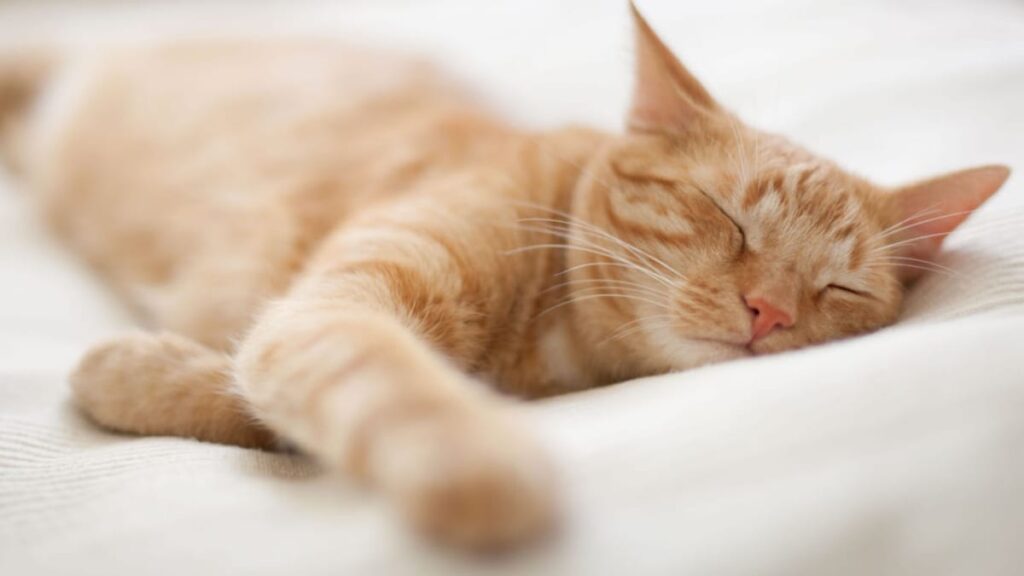Cats are fascinating creatures both awake and asleep. Our whiskered friends sleep an average of 16 hours a day, while senior cats can sleep up to 20 hours a day! But why do cats sleep so much? This is one of the most common questions among us pet tiger flatterers. In fact, it is not uncommon to realize how much our feline friend sleeps, especially when he is a little older.
In this article, we answer why cats sleep so much and explain the sleep cycle of our felines.
Why do cats sleep so much?
Have you always thought that our predator’s favorite pastime was hunting mice? Poor deluded humans! The activity (or rather, the inactivity) preferred by our domestic tiger is the take naps.
These are constant breaks and characteristics of our cat. In nature, cats are predators who must hunt for their food to survive: whether it’s a tiger or a wild cat, both are wired to hunt for food. This hunt requires a lot of time and a very high consumption of all energies which are, therefore, recovered by sleeping from 14 to 18 hours a day. In short, cats need to sleep to accumulate “spare energy”.
This instinct is also present in domestic cats, because they are psychologically structured to get their own food.
Domestic cats sleep: the nap cycle
A healthy cat sleeps at least 10 hours of deep sleep, during which his brain activity emits slow waves of different amplitudes. It is a restful sleep.
Drowsiness phase
The first phase of the nap is half-sleep: a period that lasts 20 to 30 minutes in which your cat walks slowly into the arms of Morpheus.
At this stage cats are a lot receptive to external stimuli and can react instantly.
Transitional stage
The first phase is followed by a transitional period which lasts 5 to 10 minutes to then get to the second stage proper.
REM phase
A cat’s second sleep period is called REM (as for us humans la Rapid Eye Movement is the sleep phase in which the eyeballs move), in which the animal is completely abandoned.
During this phase it may happen to see the animal moving its lower limbs while sleeping. That’s REM time.
Attention: Young kittens, like older kittens, have a slightly different sleep cycle than an adult. These cats, in fact, tend to sleep much more. If, in addition to resting a lot during the day, the cat exhibits abnormal behavior (lethargy, diarrhoea, lack of appetite), contact the vet immediately.
How do cats sleep? The meaning of the positions
Often the positions of the cat when it sleeps can tell us a lot about our pet’s sleep. Let’s see specifically.
The cat recharges at crescent
If he sleeps in a curled up position that resembles a crescent and has his tail wrapped around his body, it means that your mustachioed friend does not feel any threat or danger nearby. Cats usually sleep in this position in cold weather when they want to keep a little more warmth.
The cat hides under the covers
Does your four-legged friend always sleep hidden under the covers, in drawers, in boxes? Safe and sheltered corners and furniture coverings offer Micio safety, warmth and comfort. Just what the cat is looking for to sleep.
The cat is not fully stretched out
Cats sleeping semi-extended and with their front paws in a position reminiscent of prayer could mean that they do not feel safe and, if necessary, be able to escape quickly. It doesn’t necessarily mean that the house cat is afraid, but it can simply indicate that he is alert.
This resting position can also be a sign of a health problem. If your cat has asthma or pneumonia, he will sleep like this to avoid compressing his lungs.
The location of the eyes and ears
Even the cats who sleep with the eyes half closed and ears pricked they are on the alert and will wake up at the slightest sound, sleeping a restless sleep.
Most cats fall asleep when they are on high alert. For the first few minutes, they remain on guard before falling into a deeper sleep.
The home sleeper sleeps on his back
Finally, when the cat spends the day sleeping with its belly up it means he feels secure and happy. This type of sleeping position makes the cat’s body extremely vulnerable.
If Puss lies flat on his back while sleeping, it means that he unconditionally trusts the situation in which he finds himself.
Cat that never sleeps at night: nocturnal animals and crepuscular predators
It is normal for a cat to be active for part of the nightit is basically a partially nocturnal animal, “programmed” to hunt at dawn or dusk.
If, however, this nocturnal activity increases, it could be a sign that the cat is suffering from sleep disorders. In fact, your pet, however active at night, adapts to the rhythms of man’s life over time, “learning” to sleep more at night and less during the day.
However, stress and anxiety can be the cause of insomnia for Micio. Even some diseases, such as hyperthyroidism or hypertension, can be the basis of sleep disturbances in cats. In any case, if he sleeps too much or too little, a consultation with his veterinarian is necessary to evaluate the situation.
Isn’t the cat sleeping? Talk to the vet!
If the cat does not sleep because suffering from ailments such as anxiety or stress is possible – as long as your vet prescribes it! – give soothing drops.
As a rule, these are commercially available principals based on natural ingredients, such as Bach flowers.

